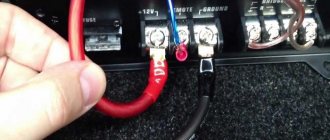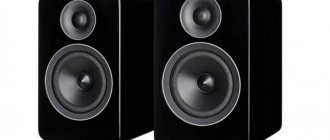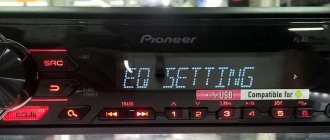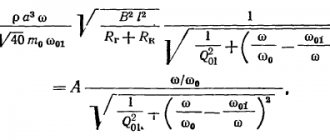Users who are thinking about purchasing a subwoofer have a variety of goals. Someone wants to improve the sound of an existing speaker system. Someone wants to get a unique feeling of body vibrations from rich, powerful bass in their car. Another part of consumers wants to create a crystal clear, completely authentic sound environment of a concert hall. An active or passive subwoofer has certain advantages and disadvantages and can solve certain problems.
What is a passive subwoofer?
A passive subwoofer is one that requires the use of an external power source such as an amplifier or receiver. Passive subwoofers are ideal for large rooms where multiple units may be needed and are preferred by home theater designers.
Both speakers and subwoofers require power from the source to produce sound. For passive subwoofers, it is important to choose an amplifier or receiver that is powerful enough to support the deep tones produced by your unit. You'll also need to consider how much power your speakers will need if you're using them with the rest of your home theater sound system.
A passive subwoofer can seem more complicated when it comes to putting all the parts together. This is because you not only have the original components, but also an additional amplifier. This means you will need more cables.
Passive subwoofers are most often used by those who have custom home theater systems. In fact, many passive subwoofers are wall- or wall-mounted as part of a custom installation. Passive subwoofers themselves are often less expensive than active subwoofers, but a custom installation and a more powerful receiver can increase this cost.
Passive subwoofers also allow you to connect multiple units together to create large or dynamic home theater rooms. This means you can distribute the bass throughout the room without creating muddy sound or worrying about uneven distribution.
Quick comparison table
Comparison of subwoofers (table):
| Criteria | Active | Passive |
| Basic components | Speaker + housing with “filling” + amplifier. | Speaker + housing with “filling”. |
| Design | Closed box, bass reflex, bandpass box. | Speaker without housing, closed box, bass reflex, bandpass box. |
| Basic kit | Column + wires | Speaker + wires |
| Final cost | Price for only one active speaker | Speaker price + amplifier price |
| Compactness | Consists of one column, does not take up much space. | Consists of a speaker and a device that amplifies the power, takes up more space. |
| Sound quality | Surround and low-frequency sound | Perfect sound, powerful and deep bass |
| Connection and setup | The speaker is connected via wires to the player via the SUB AUDIO OUT connector and is easy to set up. | The speaker is connected to the amplifier, and it is connected via wires to a player that has a SUB AUDIO OUT connector. Only a specialist can perform the setup. |
| Reliability | At maximum volume it can overheat and fail. | At maximum volume it does not overheat and does not fail. |
What is an active subwoofer?
Active subwoofers, also known as powered subwoofers, have their own power source, such as a built-in amplifier. Powered subwoofers are easy to set up and are best used in a single subwoofer configuration. For this reason, placement is more important for powered subwoofers.
Powered subwoofers are typically configured to optimize each of the built-in components. Because the built-in amplifier perfectly matches the power consumption of the speaker, active subwoofers are a versatile solution for many home theater owners and designers.
Active subwoofers do not require as many cables as their passive counterparts. This means that setup is usually easier too. At the same time, an active subwoofer requires more power (watts) to operate. This may not seem like a big deal to some when they receive their electricity bill, but it is still worth mentioning here.
Because they have everything needed for optimal bass performance, active subwoofers are usually more expensive than passive models. More importantly, when Dolby Digital 5.1 became the standard for DVDs, it set a new norm. Featuring five main channels and a low-frequency effects (LFE) channel, Dolby Digital 5.1 paved the way for a designated bass channel. (This channel continues to exist on DVDs, Blu-rays, and other discs!) Powered subwoofers typically benefit from this designated channel and can provide quality sound from one device, rather than having to use several.
Manual setting
There are special programs that can configure the subwoofer in the car. They are called tone generators. This option is simple and convenient.
But it’s not the program that will listen to music in the car, but the person. So it is recommended to make the settings yourself manually by turning on classical music. A person imagines how instruments sound. In addition, they rarely produce a frequency less than 30 Hz, thereby minimizing the level of parasitic lows.
You need to consider the size of the interior, the power of the amplifier and the direction of the music when creating a wooden box for the subwoofer.
The following filters are used:
- LPF. Cuts high frequencies. Standardly located on the amplifier. Open the regulator and turn it with a screwdriver until the frequency is 60 Hz.
- Subsonic. Responsible for cutting infrasound. Located on the rear of the amplifier. You need to turn the screwdriver so that it is 5 Hz less than the frequency of the bass reflex port.
- Adjusting the Gain level. This is the input sensitivity of the device. Located on the amplifier. First you need to turn the control to minimum and turn on the sound with a gradual increase in volume. Continue until the first defects appear. Then turn the knob back until a clear sound appears. Now you need to turn the regulator clockwise until defects appear. Then move back a few divisions.
Passive or active subwoofers: which is better?
Each type of subwoofer has its pros and cons. Each should be weighed to decide which subwoofer is best suited for your intended use. When looking for the right subwoofer, sound quality is an obvious factor. Regardless of the type of subwoofer, the quality depends more on the brand and model you choose. Besides sound quality, six key characteristics are:
- Receiver/Amplifier : Does the subwoofer require an external amplifier? If so, how strong should it be?
- Wattage : How many watts does it take to power your subwoofer? Can your receiver/amplifier handle this level of power?
- Connectivity : What types of cables and how many will you need?
- Costs : How much will the subwoofer cost? Are some types more expensive than others? Don't forget to factor in the cost of all the necessary components.
- Setup : How easy will the subwoofer be to set up? Do you just plug it in and play, or is it set up to be more complicated?
- Design : What features are included in your subwoofer? Can your subwoofer be easily integrated into your interior? Are you looking for a more personalized approach?
Let's take a look at how passive and active subwoofers stack up according to these criteria.
Pros and cons of passive subwoofers
As stated earlier, passive subwoofers are those that do not have a built-in amplifier. This can affect not only the components needed to power them, but several other factors as well.
Pros of a passive subwoofer:
- Design : Passive subwoofers allow for more customization and complete control over your home theater setup.
- Power : These subwoofers require less power (watts) to operate, which has minimal impact on your energy bill.
- Costs : Passive subwoofers are often less expensive than their active counterparts due to fewer components included in the unit.
- Setup : Works with almost any receiver/amplifier because almost all devices have subwoofer output nowadays.
- Connectivity the best option when combining multiple subwoofers to create a large home theater.
Cons of a passive subwoofer:
- Costs : Costs can increase significantly depending on the scale and types of components you need to purchase.
- Setup : The cables used to connect a passive subwoofer supply both power and signal, so you will need higher quality cables.
- Power : The full load of any amplifier used for both your speakers and passive amplifier must be considered to ensure proper power is being delivered to each connected component.
Pros and cons of active subwoofers
Powered subwoofers have fewer parts because everything you need is already included in the package. How does it compare to a passive subwoofer?
Pros of an active subwoofer :
- Connectivity : Powered subwoofers are best used in home theater systems that only require one subwoofer.
- Setup : No need for special or extensive cabling; this makes setup extremely easy.
- Design : Most powered subwoofers are built to use LFE channels, optimizing the low frequencies from a single driver.
- Amplifier : All the necessary components are built-in, meaning you don't have to research which components will provide your active subwoofer with optimal power.
- Design : Can be placed away from the receiver since the cables only carry audio signals.
- Design : Powered subwoofers are often compact and can be easily placed where needed to provide the best sound.
Cons of an active subwoofer :
- Costs : Active subwoofers are often more expensive than single passive subwoofers.
- Power : Active subwoofers require more power, which can affect your utility bill if used continuously.
- Design : Placement becomes increasingly important for powered subwoofers because only one should be used with your surround sound system.
- Compatibility : Requires your receiver/amplifier to have a subwoofer output port.
Wireless connections for subwoofers
When it comes to electronics, wireless connectivity is becoming increasingly popular. This includes your subwoofer. Currently, wireless connection is only available for powered subwoofers. Some newer models have this feature built-in. However, wireless transmitter/receiver kits are also available for older models with a home theater receiver, AV processor, or LFE ports. If you are interested in using a wireless subwoofer kit, I highly recommend the OSD Audio WSK-100 Wireless Subwoofer Kit (on Amazon).
Final verdict
While the choice of subwoofer is ultimately up to you, powered subwoofers are the most popular type used in home theaters today. Easy to use, versatile and compact, active subwoofers optimize dedicated low-frequency channels and enhance the performance of your home theater.
You'll need to pay careful attention to placement, but most owners find a powered subwoofer to be the right addition to their home theater. While the initial price may seem higher than a passive speaker, it's important to remember that you won't need any additional power from the receiver or amplifier.
That being said, if you already have a receiver with a built-in amplifier, a passive subwoofer can benefit from this feature and therefore reduce your costs. Designers favor passive subwoofers because they are ideal for flush wall mounting and allow multiple devices to be connected together. As long as your amplifier supports this configuration and provides sufficient power, a passive subwoofer is a viable option for larger rooms and custom designs.
Installation in the car
Many people are interested in how to properly connect an active subwoofer on their own. Even a beginner can handle this.
Installing an active subwoofer in a car is as follows:
- During installation, use signal and power wires. The positive cable must be connected to the “+” on the battery. It must have a large diameter.
- Install a fuse against short circuits and overloads. It is recommended to leave the part in the engine compartment, as close to the battery as possible. If needed, there will be free access to it.
- Secure the negative cable to the vehicle body. For this, a nearby point is used. You will get a “-” connection between the weight of the body and the GND of the device.
- If the car radio has separate connectors, then the connection with the active device is more convenient. It is required to lay a coaxial type wire in the screen with the required connector. The cable is fixed on one side with the SubOut output on the car radio, and on the other with Lineln on the subwoofer.
This connection scheme is the most common. It can also be used after equipment repair.
There are several ways to connect to a stereo amplifier:
- The subwoofer is connected to the outputs to which the speaker systems are already connected. There will be parallel work in the low frequency range.
- You can connect the subwoofer to the receiver, and the acoustics to the outputs on the subwoofer itself. In front of them are high-pass filters, which will eliminate wheezing, noise, etc. But you need to take into account that with this connection method, the load on the speaker system increases, so it may break.
Do I really need a subwoofer? Aren't my speakers good enough?
Surround sound systems provide a wide range of pitches and sounds. However, most of these speakers don't have the range or ability to reproduce or produce truly deep, rich bass tones. This is exactly what subwoofers were made for. At the same time, the subwoofer enriches the home theater experience and helps the speakers reproduce the full range of sounds. In fact, subwoofers have become practically mandatory if you ask a home theater design expert.
Does size matter?
Subwoofers come in different sizes. A traditional subwoofer that was housed in a large cabinet may be too large for some rooms. However, newer technologies have helped manufacturers reduce the size of components, as well as the dimensions of many subwoofers available today. This makes them easier to hide and even install in a wall or closet.











